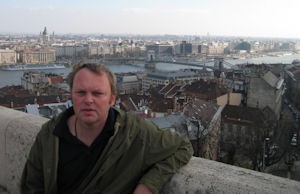 |
Sat in my house. I receive a text: a taxi will arrive in a few minutes. get in it.Am I in a real life James Bond film ?. Where will I be taken ?. What will happen ?.
Nothing so drastic. After nearly a year of UK based adventures, I have arranged a budget long weekend in Budapest.
I am going with my friend Glenn and work commitments, mean he can’t pick me up directly, so he’s sent a cab on account.
I arrive in Mickel Trafford and we drive to the airport. The adventure has begun.
This photo was taken on Castle hill, overlooking the famous Chain bridge. |
| More excitement, as we arrive at the airport.Glenn has membership of a private lounge. We get a couple of “free” beers and a bacon butty.
Later we read the papers and have a go on this Scalextric (which was set up to entertain children, but we didn’t care). |
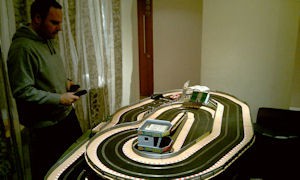 |
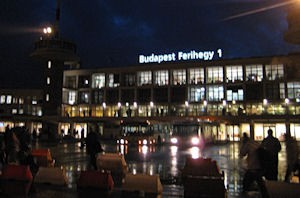 |
So why Budapest ?.I’ve always been fascinated by Eastern Europe as I grew up during the cold war.
Several of my friends had recommended it, and since I hadn’t visited Hungary before, the decision was easy.
Its history is impressive. It has been controlled by empires of the Celts, Romans, Mongols, Ottomans, Austrians, Germans and Russian.
Pest and Buda were the furthest lying areas of the Ottoman and Austrian empires.
On the 17th November 1873 Buda, Obuda and Pest (for simplicity’s sake, Pest is the hill, and the 2 others are flat, on the other side) was unified and became one city.
This vibrant mix of cultures, is what makes Budapest so Cosmopolitan. Its easily the nicest Eastern European city that I’ve ever visited. |
| Were on a budget, so we stay in a backpacker hostel – the 7×24 Central Hostel. The building actually contains a dental surgery, which is listed as one of the hostels services, along with no lock-out and free internet.
We are met by our host Agi (who owns a Trebant) and given our complimentary drink of Palinka.
We are shown around the hostel, which was bright and spotlessly clean. The living room had a really big tv, comfy sofa and a kitchen for making hot chocolate (and other types of cooking as well, I suppose).
She speaks with enthusiasm in broken English. An accomplished traveller herself, she leads us to a map on the wall, and gives us a whistle stop tour of Budapest.
She raves about a bar around the corner called the Katapult. We decide to stay local since its our first evening and visit the amazing Trofea Grill.
All you can eat, normally puts me off, but the food was amazing, and you could drink as much bear and wine and eat as much steak and stuff like that as you liked, for a tenner. |
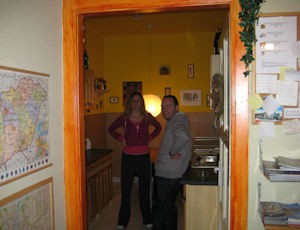 |
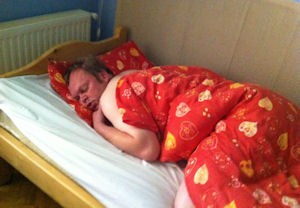 |
A friend once told me, when your on holiday, let your body take the rest it needs from you. I slept really well each night, and occasionally, slept in.
On this particular occasion, Glenn didn’t sleep in, so was able to take this awful picture of me. |
| In the morning, we head out exploring (later in the trip, I lent my priceless DK Eyewitness guide to some French people, who lost it !).
We walk along the famous Andressy Utca (a world heritage site), with its fine buildings and town houses.
Glenn has been doing some research as well. I didn’t realise it, but the most popular souvenirs are maps.
Budapest has an international reputation for map making (back in the days when British cartography consisted of “here be wild beasts”). |
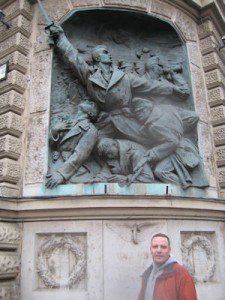 |
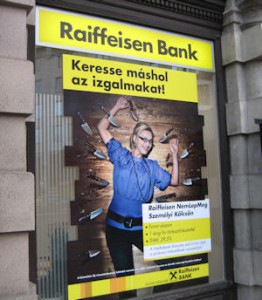 |
As well as being steeped in history, the city was very modern. Many of the people we passed in the morning were dressed in business attire.
I have no idea what this bank advertisement is saying, but with the flying knives, it captured my experience dealing with and visiting banks exactly. |
| At the top of Andressy Utca, is heroes’ square and the Millennium Monument with statues of the 7 tribes that founded Hungary in the 9th century.
The monument was constructed to celebrate Hungary’s the 1000’th anniversary in 1896, but wasn’t completed until 1900.
The square is complimented by the Museum of Fine Arts on its left and the Hall of Art on the right.
The Serbian embassy is next to the square on Andrassy utca, and its here that Imre Nagy secured sanctuary in 1956.
On the 16th of June 1989 a quarter of a million people, gathered for Nagy’s reburial (he was executed by the Soviets in June 1958).
During the soviet occupation of Hungary, the Monument was completely covered by red textile and a statue of Marx, a worker and a peasant replaced many of the historic national heroes statues which were removed. |
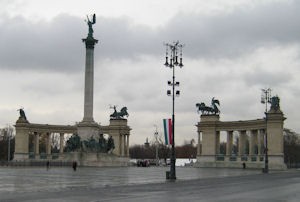
|
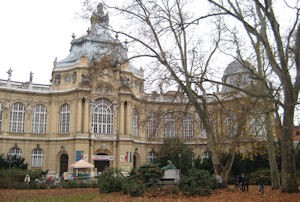 |
Vajdahunyad Castle in city park was built between 1896 and 1908. Copied from a Transylvanian castle, it incorporates Romanic, Gothic, Renaissance and Baroque styles.
I was surprised to find it was originally made of cardboard and wood from the thousand year celebrations, and proved so popular that it was rebuilt from stone and brick. |
| As we wander further around, I realise that the moat was empty. A bit disappointing.
In the castle courtyard, one of the most famous statues in Hungary, Anonymous. Reckoned to be a 12th century chronicler, he wrote the first history books (made up mostly of superstition and legend)’
Touching his pen is supposed to be lucky. It was so popular that there was a queue to photograph it. |
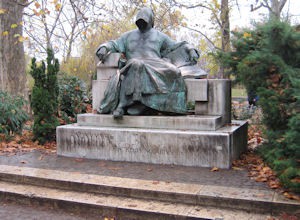 |
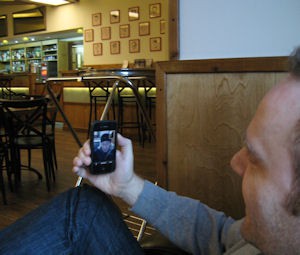 |
Just outside Vidam park, we find this sort of rock bar (well it had posters of famous rock bands, I just wasn’t sure if any of them had ever played there).
Glenn comments that its time for a drink. I start to wonder what sort of trip this will turn out to be !.
He has coke, and I have coffee.
An impromptu “meeting” with this business partner Rob using apple’s facetime and the bars wireless network, demonstrates just how cool technology can be. |
| “When I am drinking wine” wrote Petofi Sandor, Hungary’s national poet “I am happy and I don’t care who is in power”
The House of Terror museum, showed that not everyone felt the same way.
It chronicled the atrocities committed against the Hungarian people by the Nazis and the Communists.
The building had been used as an interrogation centre for the AVH secret police.
I walked through a bright room showing Communist propaganda, and then the room next to it, that showed the reality. Poorly designed tin openers and radios that don’t work.
There was some stuff about the 56 uprising including a video of the show trail of Imre Nagy.
Most harrowing was a a slow lift journey, with a video interview explaining the daily hangings. |
 |
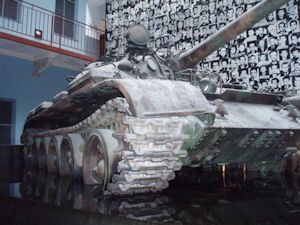 |
A T34 tank of the kind used by the Russians to quell the 56 uprising, was located in the foyer of the museum.
The pictures behind the tank, show just some of the victims of communist attrition. One very meaningful exhibit said:
“Communism turned almost everyone and everything against itself. To tell a joke., to show too little enthusiasm, or give money to families of “social outcasts” or even just to nod at them. Anyone, who did not applaud loud enough, came under suspicion.
The brave ones, who defied the atrocious terror regime, were wiped out and buried in unmarked graves, because even in death they represented a threat.
The oppressive system did everything in its power to eradicate event their memories. Those, who risked their lives for the freedom of their country, were branded spies and traitors.
We do not know the names of many of them, and old lies still keep circulating about some of them. Yet they were true heroes”.
The last soviet advisor’s left Hungary in 1989. |
| I had a fairly focused idea of things to see and we blasted through the city on our pre-planned agenda.
I had to remind myself though, that the 3 days we were away, were the only holiday I would have that year, and to take time to enjoy it, rather than just see it as an expedition.
We passed by a railway station, and for no particular reason, decided to go inside and look around.
Nyugati railway station. Trains run from here to the airport 3 times an hour for £1. |
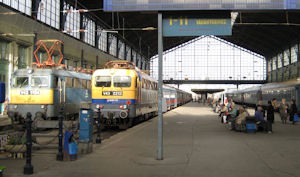 |
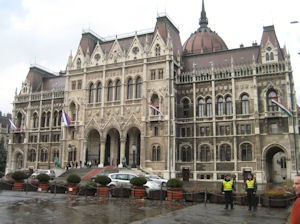 |
The Hungarian parliament building (its sited on the banks of the Danube, but you can’t see from this photo).
Modelled on the houses of parliament in the UK, it is the biggest parliament in Europe, and the largest building in Hungary.
The architect, Imre Standle went blind before its completion.
Mátyás Szűrös declared the Hungarian Republic from the balcony facing Kossuth Lajos tér on 23rd October 1989. |
| It was the anniversary of the uprising while we were there.
I’d read previously about the 1956 uprising. A spontaneous, nationwide revolt against the Stalinist government and the courage and ingenuity of the Hungarians.
The uprising took place between the 23rd of October and the 10th of November. Its was the anniversary, while we were there, and this tribute had been put up outside the parliament building with cards and flowers from people who had lost loved ones in the fighting.
The flag with the hole in the middle (hammer and sickle cut out) became a symbol of the revolution.
The new government formally disbanded the ÁVH, declared its intention to withdraw from the Warsaw Pact and pledged to re-establish free elections. By the end of October, fighting had almost stopped and a sense of normality began to return.
After announcing a willingness to negotiate a withdrawal of Soviet forces, the Politburo changed its mind and moved to crush the revolution. |
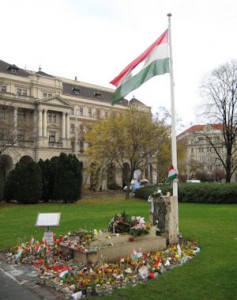 |
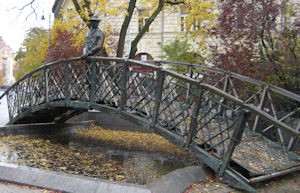 |
On 4 November, a large Soviet force invaded Budapest and other regions of the country.
Hungarian resistance continued until 10 November. Over 2,500 Hungarians and 700 Soviet troops were killed in the conflict, and 200,000 Hungarians fled as refugees. Mass arrests and denunciations continued for months thereafter. By January 1957, the new Soviet-installed government had suppressed all public opposition. These Soviet actions alienated many Western Marxists, yet strengthened Soviet control over Central Europe.
Public discussion about this revolution was suppressed in Hungary for over 30 years. October the 23rd is a national holiday.
As I wandered along, I found this statue of Imre Nagy. I learned that the revolt had originally begun as a student uprising.
Later that day in the hostel, I would see live footage of the Milbank protest in London. The irony disgusted me. |
| Security around the US embassy was understandably tight so I had to use this stock photo I found on the web.
On November 4, 1956, Cardinal Mindszenty walked up to the Chancery door. His Monsignor interpreter, they asked to come into the U.S. Embassy.
The low ranking corporal wasn’t sure what to do, but since he had the keys, he let the cardinal into the embassy where he stayed in internal exile for the next 15 years !.
The Cardinal used what is now the Ambassador’s office as his salon or sitting room, and he slept in the other, smaller room to the side.
The police outside the Chancery were ever watchful should he try to escape, and they ran their engines day and night, 24 hours a day, 7 days a week, just in case.
The memorial plaque reads: “The Government of the United States of America gave shelter to Cardinal Joseph Mindszenty in this building between November 4, 1956 – September 28, 1971” |
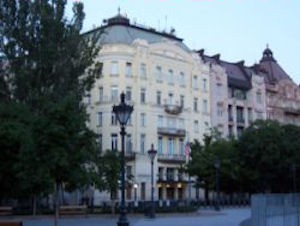 |
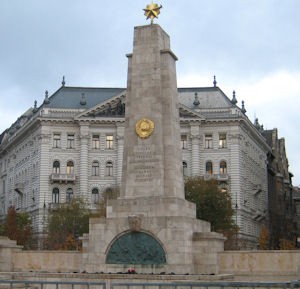 |
Budapest previously had dozens of Soviet monuments and memorials.
After independence, the Russian government were informed that they would all be removed except one and let the Russians decide which.
This one remains, directly facing the US embassy. |
| After a busy day exploring, we head back to the hostel, and get cleaned up.
I’m not particularly patriotic (although I am proud to be british and come from Manchester). Like many people abroad, I suddenly become more British, Irish, American etc when I’m in another country.
It was the City/United Derby that evening and we decided to go an watch the match.
The sports bar we found was a bit expensive (£3 rather than the usual £1.10 per pint) but was very quiet and enabled us to watch the match in peace.
A bit disappointing since neither side scored and the game was rather uneventful. |
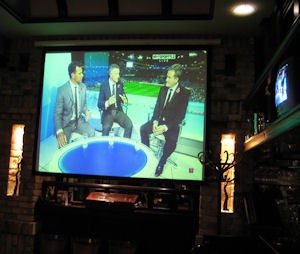 |
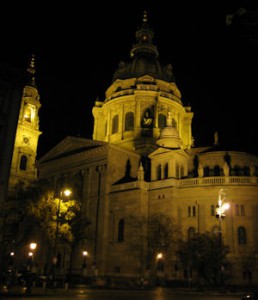 |
As we walk back, I get this night shot of St Stephens Basilica.
In the evening, I found the area friendly and following normal/sensible security precautions, didn’t have any problems with theft, pickpockets at all. |
| The following morning I am not photographed sleeping, we get up, get some breakfast and head for Castle hill.
Although the City was beautiful, we still found homeless people living in the doorways of these arches, just a few yards from a 5 star hotel. |
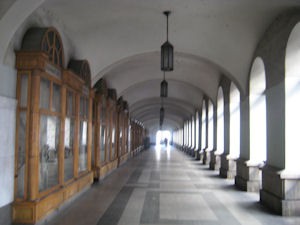 |
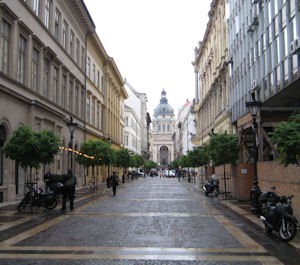 |
This picture shows St Stephens Basilica in the daylight.
The Basilica, like the Parliament building, is 96m high, they are jointly the 2 tallest buildings in Budapest.
This is to symbolise that worldly and spiritual thinking have equal importance and present building regulations make the building of taller buildings within the city an offence. |
| Roosevelt square (it had previously been called Unloading square !).
It had some of the most beautiful architecture (and worst traffic) in the whole city.
The 4 season Gresham hotel, is voted 17th in the top 100 hotels in the world (and is only 2nd in Europe).
For fun, we looked at spending the night there. We couldn’t find anything under £600 per night !. |
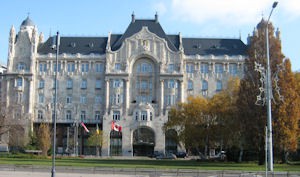 |
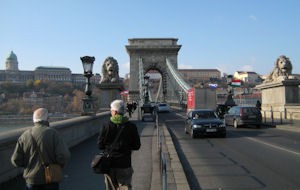 |
Opposite the Gresham hotel is the Chain bridge, the first built over the Danube.
When first constructed it was rated as a wonder of the world and had positive economic and commercial implications for the entire country.
It was designed by William Tierney Clark. A larger versions of Clark’s Marlow Bridge, built across the River Thames in the UK, not surprisingly, in Marlow. |